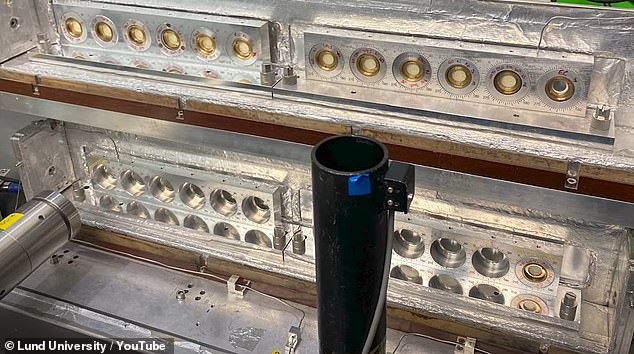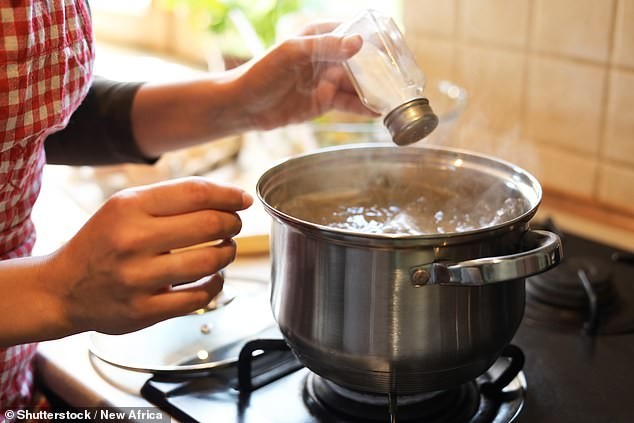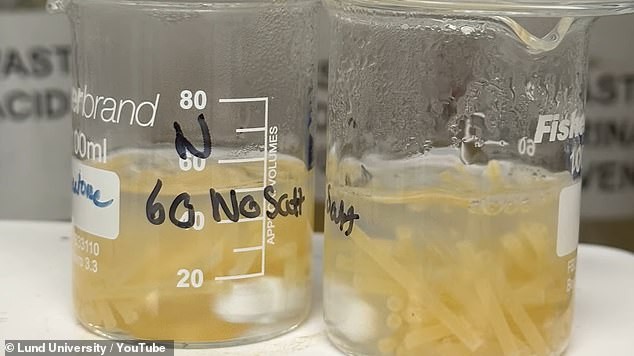You're Cooking Pasta Wrong—Scientists Reveal the Exact Salt You Should Add to Water
You might think you can't go wrong with cooking pasta – all you need is boiling water, a pinch of salt and a couple of stirs with a spoon. But for those who regularly end up with a mushy, overcooked mess, scientists have now unearthed a key step in the process. 7g per litre of water is needed – the equivalent of over a teaspoon. And this is essential to prevent your spaghetti from disintegrating while boiling. 'Cooking pasta with the right amount of salt is not just a matter of taste,' Andrea Scotti, senior lecturer of Physical Chemistry at Lund University, wrote on The Conversation. 'What we found is that salt doesn't just make pasta taste better; it also strongly affects the microstructure of the spaghetti and thus the whole dining experience. 'So how much salt should you add to preserve the pasta's microscopic structure? Our study revealed that the optimal salt level is 7g per litre of water, with more water required for larger amounts of pasta.' According to online calculators, 7g of salt is roughly the equivalent of 1.25 teaspoons.

In This Article:
- Exact Salt Amount: 7 g per Liter of Water
- Salt Alters Pasta Microstructure and Dining Experience
- Advanced Techniques and the Ideal Boil Time
- Gluten in Regular Pasta Acts as a Safety Net
- Gluten-free Pasta Requires Exact Cooking Conditions
- Regular Pasta Tolerance and the Quest for Gluten-free Durability
- Pasta Al Dente: Testing Cooking Methods
- MIT Spaghetti Fracture Device: Building a Mechanical Fracture Tool
Exact Salt Amount: 7 g per Liter of Water
7g per litre of water is needed – the equivalent of over a teaspoon. This is essential to prevent your spaghetti from disintegrating while boiling. The study's findings were reported by Andrea Scotti, senior lecturer of Physical Chemistry at Lund University: 'So how much salt should you add to preserve the pasta's microscopic structure? Our study revealed that the optimal salt level is 7g per litre of water, with more water required for larger amounts of pasta.' Experts also note that, according to online calculators, 7g of salt is roughly the equivalent of 1.25 teaspoons.

Salt Alters Pasta Microstructure and Dining Experience
'What we found is that salt doesn't just make pasta taste better; it also strongly affects the microstructure of the spaghetti and thus the whole dining experience.' The team set out to understand how salt interacts with pasta at a microscopic level, beyond flavor alone.

Advanced Techniques and the Ideal Boil Time
The team used advanced techniques, including particle accelerators and neutron facilities, to shed light on how the hidden structure of spaghetti changes as it cooks. They also discovered that pasta should ideally be cooked for 10 minutes to achieve the perfect consistency.

Gluten in Regular Pasta Acts as a Safety Net
'We were able to show that the gluten in regular spaghetti acts as a safety net that preserves the starch,' Mr Scotti said. The gluten in regular spaghetti helps protect the pasta's structure during cooking.

Gluten-free Pasta Requires Exact Cooking Conditions
'The gluten–free pasta, which contains an artificial matrix, only works optimally under exactly the right cooking conditions – otherwise the structure easily falls apart.' The researchers emphasize the fragility of gluten-free formulations under suboptimal cooking. The most extreme example of this degradation occurred when the gluten–free spaghetti was cooked for too long, for 13 minutes, and in very salty water, they said.

Regular Pasta Tolerance and the Quest for Gluten-free Durability
'Our results show that regular pasta has a higher tolerance, or better structural resistance, to less optimal cooking conditions such as being cooked for too long or too much salt being added to the water,' Mr Scotti added. 'The team said they hope the findings can help develop more durable gluten–free pasta alternatives that can stand up to the demands of the cooking process.'

Pasta Al Dente: Testing Cooking Methods
The researchers tested different ways of cooking pasta to work out the best conditions for the perfect al dente dish.

MIT Spaghetti Fracture Device: Building a Mechanical Fracture Tool
Two MIT students, Ronald Heisser and Vishal Patil, built a mechanical fracture device to uncontrollably twist and bend sticks of spaghetti. Two clamps on either end of the device held a stick of spaghetti in place. A clamp at one end could be rotated to twist the dry noodle by various degrees, while the other clamp slid toward the twisting clamp to bring the two ends of the spaghetti together, bending the stick. They used the device to bend and twist hundreds of spaghetti sticks and recorded the entire fragmentation process with a camera, at up to a million frames per second. They found that by first twisting the spaghetti at almost 360 degrees, then slowly bringing the two clamps together to bend it, the stick snapped exactly in two. They found that if a 10-inch-long spaghetti stick is first twisted by about 270 degrees and then bent it will snap in two. The snap-back, in which the stick will spring back in the opposite direction from which it was bent, is weakened in the presence of twist. And, the twist-back, where the stick will essentially unwind to its original straightened configuration, releases energy from the rod, preventing additional fractures.

